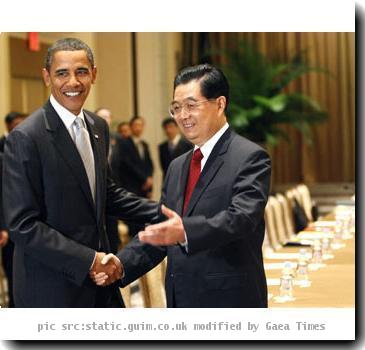China’s top leaders say Tibet development must include neighboring Tibetan areas
By Cara Anna, APFriday, January 22, 2010
China eyes grand plan to develop Tibetan regions
BEIJING — China’s top leaders say Tibet’s development must include Tibetan areas in neighboring provinces — a move likely aimed at tying the region tighter to the rest of the country after deadly riots two years ago.
Chinese President Hu Jintao told the first high-level meeting on Tibet in nine years that the development would require hard work to prevent “penetration and sabotage” by separatists working for Tibet’s independence, the state-run Xinhua News Agency reported late Friday.
Hu also said at this week’s meeting that residents’ awareness of being part of China should be constantly enhanced, Xinhua reported.
The meeting was the first of its kind since the deadly riots in March 2008, the largest uprising against Chinese rule in decades. Chinese-owned shops and government offices were attacked in Tibet’s capital, Lhasa, and other traditionally Tibetan regions of western China. The government says at least 22 people were killed in Lhasa, and Tibetan rights groups say nearly 140 Tibetans died.
Beijing, which sent troops to occupy Tibet following the 1949 communist revolution and insists it has been part of Chinese territory for centuries, has sped up its drive to develop the region’s economy since the violence.
China’s leaders agreed in the meeting Monday through Wednesday to develop Tibetan regions in neighboring Sichuan, Gansu, Yunnan and Qinghai provinces as well, Xinhua said. Most, if not all, saw protests shortly after the 2008 violence.
One expert on Tibet said China’s leaders like to “homogenize” Tibet’s problems as a development issue to downplay the region’s distinct culture.
“They’re persisting in this argument that it’s all about money and that Tibetans have no other concerns,” said Michael C. Davis, a professor at the Chinese University of Hong Kong. “Including or connecting the Tibetan Autonomous Region with other autonomous areas may just be more of that. Maybe I’m too suspicious.”
Davis said the move to include areas outside Tibet in the development drive seems to be more about connecting them to the rest of China than to each other.
The research director for the government-backed China Tibetology Research Center, Lian Xiangmin, told the Hong Kong-based South China Morning Post in a report Saturday that widening the development focus to other Tibetan areas was a major policy change.
Reports on the Tibet meeting gave no details on how much money would be poured into the region, but Hu said the per capita income of Tibet’s farmers and herdsmen should be close to the national level by 2020, Xinhua reported. As of last year, it was barely one quarter of the national average of around $2,000 a year, according to the government.
China this month appointed a former soldier as Tibet’s new governor, reasserting hardline policies there in the face of resentment over political restrictions and perceived economic exploitation.
But the governor’s post is largely ceremonial. Tibet policy is formulated at the highest levels of China’s central government under Hu, who was Tibet’s party boss from 1988 to 1992.
Tags: Asia, Beijing, China, East Asia, Greater China, Hong Kong, Hu Jintao, Tibet

